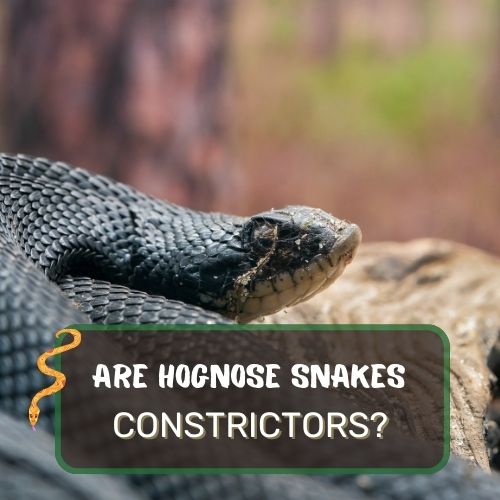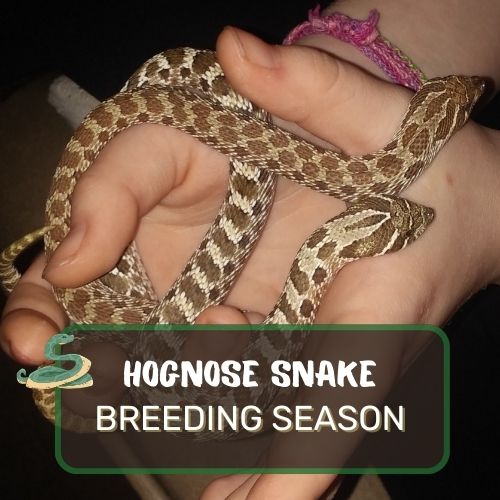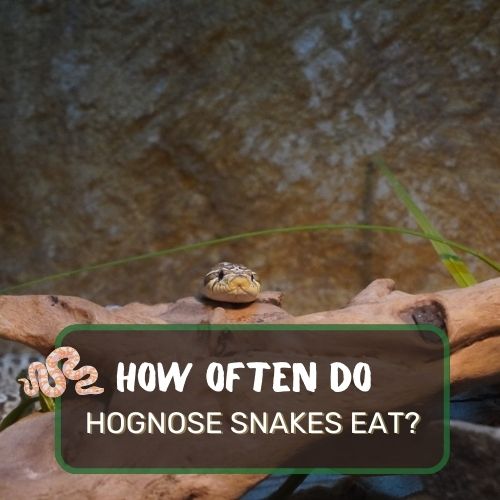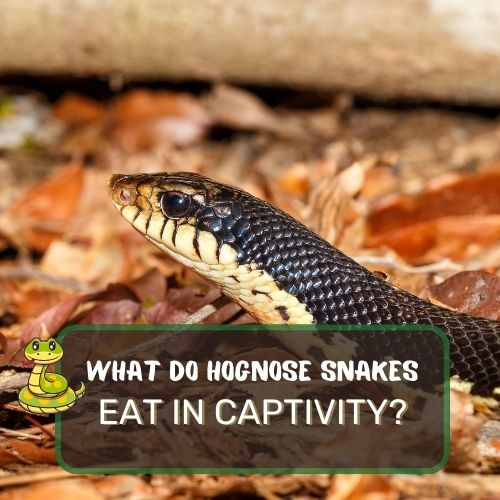
When the question “are hognose snakes constrictors?” arises, it’s not just a matter of simple yes or no.
The world of snakes is vast, intricate, and filled with fascinating behaviors that often blur the lines of our understanding.
In this article, we’ll delve deep into the realm of hognose snakes, exploring their unique characteristics, behaviors, and how they compare to the more commonly known constrictor snakes.
By examining factors like feeding habits, physical traits, and natural behaviors, we aim to provide a comprehensive answer.
So, whether you’re a curious soul, a reptile enthusiast, or someone considering a hognose as a pet, this article promises insights that will both educate and captivate.
Table of Contents
Are Hognose Snakes Constrictors?
Hognose snakes are fascinating creatures known for their upturned snouts and unique behaviors. While many people associate the term “constrictor” with snakes that wrap around their prey to immobilize it, hognose snakes don’t primarily use this method. Instead, they are more famous for their “bluffing” tactics, where they play dead or hiss to deter predators. When it comes to feeding, they mostly prey on amphibians, especially toads, using their rear fangs to deliver a mild venom. So, in short, hognose snakes are not constrictors in the traditional sense, but rather, they have their own distinct methods of capturing prey.
Hognose Snake Behavior and Feeding Habits

Hognose Snake Behavior: More Bluff than Bite
Hognose snakes are true masters of deception. When threatened, they often resort to a series of dramatic behaviors. One of their most famous acts is “playing dead.”
In this theatrical display, the snake will roll onto its back, open its mouth, and even stick out its tongue, mimicking death.
If that doesn’t deter a potential threat, they might hiss loudly or spread their necks, similar to a cobra, in an attempt to appear more intimidating.
Feeding Habits: A Toad’s Worst Nightmare
When it comes to their diet, hognose snakes have a particular fondness for amphibians, especially toads. Their unique upturned snouts are perfect for digging and unearthing these hidden meals.
But toads have a defense mechanism: they inflate their bodies to avoid being swallowed. Hognose snakes, however, have evolved rear fangs and a mild venom that can subdue their prey, making the inflated defense tactic ineffective.
This venom is not harmful to humans but is quite effective on their chosen prey. It’s a specialized adaptation that showcases the intricate balance of predator and prey in nature.
How They Compare With Other Constrictor Snakes

The Art of Constriction: Traditional Constrictors
Constrictor snakes, like boas and pythons, employ a powerful method to subdue their prey. They coil around their catch, tightening their grip each time the prey exhales, preventing it from taking another breath.
This method is both efficient and effective, allowing these snakes to tackle prey much larger than themselves.
Hognose Snakes: A Different Approach
In contrast, hognose snakes don’t rely on constriction. Instead, they have evolved a set of behaviors and tools tailored to their specific diet of amphibians.
Their rear fangs and mild venom are perfect for subduing toads, which are their primary prey. While they might not have the raw power of a boa constrictor, their specialized adaptations make them just as effective in their niche.
A World of Diverse Strategies
The animal kingdom is vast, and within the world of snakes, the diversity is astounding. While constrictor snakes rely on strength and endurance, hognose snakes use cunning and specialized tools.
Each species has found its unique way to thrive, showcasing the incredible adaptability and evolution of nature.
What are Constrictor Snakes?
When you hear the word “snake,” what’s the first image that pops into your mind? For many, it’s the iconic image of a snake coiled around its prey, squeezing the life out of it.

But not all snakes are constrictors, and not all constrictors are the massive, jungle-dwelling creatures we often imagine.
So, let’s dive into the world of constrictor snakes and see how they stack up against the intriguing hognose snake.
Definition and Characteristics
Constrictor snakes are a diverse group, but they all share one common hunting technique: they immobilize their prey by wrapping their muscular bodies around it and squeezing. Think of it as a deadly embrace.
These snakes can be found in various families, including the Boidae (boas) and Pythonidae (pythons).
From the petite sand boa hiding beneath the desert sands to the awe-inspiring reticulated python that reigns supreme in the jungles, constrictors come in all shapes and sizes. Their bodies are powerhouses, built for strength and endurance.
But here’s a fun fact: not all constrictors are giants. Some are just as small and unassuming as our friend, the hognose snake.
How Constriction Works
Imagine you’re wearing a corset, and with every breath you take, someone tightens it a notch. Uncomfortable, right? That’s essentially how constriction works.
When a constrictor snake spots its next meal, it strikes with lightning speed, latching onto the prey with its sharp teeth. In a fluid motion, it wraps its body around its catch.
But contrary to popular belief, the snake isn’t trying to crush its prey. Instead, it’s restricting the prey’s ability to breathe. With every exhale, the snake tightens its grip, making it impossible for the prey to take another breath.
It’s a method that’s both efficient and effective, ensuring the snake a hearty meal with minimal risk.
Now, with this understanding of constrictor snakes, one might wonder: “Are hognose snakes constrictors?” Well, while they might share the same slithery form and some behavioral traits, hognose snakes have their own unique set of tools and tactics.
They’re more about bluff and bluster than brute strength. But that’s a story for another day.
Popular Constrictor Snakes
The world of constrictor snakes is vast and varied. From the dense jungles of Asia to the arid deserts of North America, these remarkable reptiles have adapted to a wide range of environments.

Let’s embark on a journey to meet some of the most popular constrictor snakes and discover what makes each of them unique.
Burmese Python
The Burmese Python, native to the jungles of Southeast Asia, is a true giant in the snake world. Often reaching lengths of over 12 feet, these pythons are known for their striking patterned appearance and their voracious appetites.
They primarily prey on birds and mammals, using their powerful bodies to constrict and immobilize their catch. Due to their size and exotic look, they’ve become popular in the pet trade, but they require experienced handlers.
Boa Constrictor
Boa Constrictors are native to the Americas and are known for their impressive size and varied color patterns. Unlike the Burmese Python, Boa Constrictors can be found in a range of habitats, from tropical rainforests to arid deserts.
They’re ambush predators, lying in wait for the perfect moment to strike their prey. Their name might sound menacing, but with the right care, they can be docile pets.
Kingsnake
Kingsnakes are the royalty of the snake world, and for a good reason. Found across North America, these snakes are known to eat other snakes, including venomous ones!
Their immunity to certain snake venoms gives them a unique advantage. With their vibrant patterns and relatively smaller size, Kingsnakes are often a favorite among reptile enthusiasts.
Milk Snake
Milk Snakes are close relatives of the Kingsnake and share many of the same traits. Their name is a nod to an old myth that they suck milk from cows (they don’t!). These snakes are known for their stunning red, black, and white bands.
Like the Kingsnake, Milk Snakes have a varied diet and can even consume other snakes.
Royal Pythons
Also known as Ball Pythons, Royal Pythons hail from Africa. Their name “Ball Python” comes from their tendency to curl into a ball when threatened. These pythons are smaller, making them popular pets.
They come in a plethora of color morphs, each more breathtaking than the last.

Reticulated Python
The Reticulated Python holds the title for the longest snake in the world, with some individuals reaching over 20 feet! Native to Southeast Asia, these pythons have a striking net-like pattern, giving them their name.
They’re apex predators in their habitat, capable of taking down larger prey like deer.
Jungle Carpet Python
Hailing from the land down under, the Jungle Carpet Python is a vibrant snake known for its striking yellow and black patterns. They’re arboreal, often found draped over tree branches, waiting for prey.
While they’re smaller than some of their python cousins, they’re no less captivating.
Corn Snakes
Corn Snakes are the darlings of the snake world. Native to North America, they get their name from the corn-like pattern on their bellies. They’re docile, easy to care for, and come in a variety of beautiful morphs.
Their gentle nature and manageable size make them perfect for beginner snake enthusiasts.
Importance of Understanding Snake Behavior
Snakes, with their slithering elegance and mysterious demeanor, have long captured human fascination. But beyond the allure lies a creature driven by instinct and behavior patterns that are crucial for survival.

Understanding these behaviors is not just a matter of curiosity; it’s essential for safety and harmonious coexistence, especially for those who choose to keep these reptiles as pets.
Safety Precautions
Snakes, like all wild animals, can be unpredictable. Recognizing signs of stress, agitation, or fear in a snake can mean the difference between a peaceful encounter and a potentially dangerous situation.
For instance, a rattling tail, hissing, or a coiled posture can indicate a snake feeling threatened.
By understanding these behaviors, humans can take steps to give the snake space or avoid sudden movements, reducing the risk of bites or other defensive actions.
Importance for Pet Owners
For snake enthusiasts who bring these creatures into their homes, understanding behavior is paramount. Recognizing when a snake is hungry, shedding, or feeling territorial can help pet owners provide the right care and environment.
It also ensures the well-being of the snake, preventing unnecessary stress or health issues. Moreover, a well-understood and cared-for snake is less likely to exhibit aggressive behaviors, making the experience more enjoyable and safe for the owner.

Conclusion
As you’ve journeyed through this article, you’ve unraveled the mysteries surrounding the intriguing question: are hognose snakes constrictors?
You’ve delved into the world of constrictor snakes, understanding their defining characteristics and how they differ from the unique hognose snake.
You’ve also gained insights into the diverse behaviors and feeding habits of various snake species, highlighting the importance of understanding these creatures for both safety and appreciation.
It’s essential to remember that every snake, from the mighty constrictors to the dramatic hognose, plays a vital role in our ecosystem. Their behaviors, adaptations, and lifestyles are a testament to nature’s incredible diversity and adaptability.
As you move forward, let this newfound knowledge inspire a deeper respect and admiration for these remarkable reptiles.
And remember, every question you ask and every article you read brings you one step closer to becoming a true advocate for the natural world. Keep that curiosity alive, and never stop learning!
FAQ
Navigating the world of snakes can be a maze of myths, misconceptions, and genuine curiosity. Here, we address some frequently asked questions about the intriguing hognose snake.
What is unique about a hognose snake?
Hognose snakes are truly one-of-a-kind! Their most distinctive feature is their upturned snout, which they use for digging in sandy or loose soils. Additionally, they have a flair for the dramatic. When threatened, they might play dead by rolling onto their back, mouth agape, and tongue hanging out. It’s a performance that often leaves predators (and humans) baffled!
How friendly are hognose snakes?
While no wild animal is truly “friendly” in the way domesticated pets might be, hognose snakes are generally docile and less aggressive than some other snake species. With regular, gentle handling, they can become accustomed to human interaction, making them popular pets among reptile enthusiasts.
Is a hognose snake an adder?
No, hognose snakes are not adders. While both have rear fangs, adders are a group of venomous snakes found mainly in Europe. Hognose snakes, on the other hand, have a mild venom that’s effective on their prey but generally harmless to humans.
Why are they called hognose snakes?
The name “hognose” is derived from their unique upturned snout, which resembles a pig’s nose. This specialized nose aids them in digging and burrowing, especially when hunting for their favorite meal: toads.




0 Comments